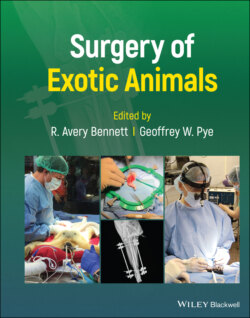Читать книгу Surgery of Exotic Animals - Группа авторов - Страница 62
Reptiles and Amphibians
ОглавлениеA few studies have evaluated sutures in reptiles and a single study evaluated suture materials in amphibians (Tuttle et al. 2006). Five suture materials (silk, monofilament nylon, polydioxanone, polyglactin 910, and chromic gut) were evaluated in African clawed frogs (Xenopus laevis) to determine which suture material elicited the fewest inflammatory changes in amphibian skin over 14 days. All sutures caused significantly more inflammation than a stab incision that was left to heal by second intention. Chromic gut and silk caused significantly more inflammation than all other sutures and 67% of incisions closed with silk sutures dehisced. Polydioxanone and polyglactin 910 caused significantly more inflammation than monofilament nylon. There were no significant differences in scores between 7 and 14 days. Based on these results, chromic gut and silk are not recommended and monofilament nylon may be the most appropriate suture in amphibian skin.
Using absorbable suture may result in premature suture material dissolution and wound dehiscence in aquatic amphibians (Baitchman and Herman 2015). Alternatively, cyanoacrylate tissue adhesive has been used for skin closure both in terrestrial and aquatic amphibians because it is waterproof. Studies are needed to compare cutaneous healing following suture or cyanoacrylate tissue adhesive application in amphibians. The use of polydioxanone has been reported anecdotally for amphibian internal organs (Green 2010; Norton et al. 2014).
Early studies on wound healing in reptiles compared sutured and unsutured wounds in garter snakes (Smith et al. 1988). Paired 1 cm incisions were either sutured with 5‐0 polypropylene or left to heal by second intention. They showed that unsutured wounds had significantly less disruption of scale pattern and overlap of wound margins, and less‐intense inflammatory infiltrates.
Four different suture materials (chromic gut, polyglyconate, polyglactin 910, and poliglecaprone 25) were evaluated histologically 7 days following laparoscopic sex determination (Govett et al. 2004). Results indicate that poliglecaprone 25 and polyglyconate caused the least tissue reaction of the four suture types examined. These synthetic monofilament absorbable suture materials caused significantly less crust formation and panniculus inflammation than chromic gut and polyglactin 910.
A study evaluated eight suture materials (polydioxanone, polydioxanone/triclosan, poliglecaprone 25, poliglecaprone 25/triclosan, polyglactin 910, chromic gut, monofilament nylon, and surgical steel) and cyanoacrylate tissue adhesive in hatchling ball pythons over a period of 90 days (McFadden et al. 2011). Samples were evaluated histologically at 3, 7, 14, 30, 60, and 90 days following implantation. Over all time points, all suture types caused significantly more inflammation compared to the negative control. Cyanoacrylate tissue adhesive did not cause significantly more inflammation than the negative control at any time point suggesting that small superficial skin incisions or lacerations can be closed with cyanoacrylate tissue adhesive. All suture materials caused chronic inflammatory responses that were significantly higher than the negative control 90 days following suture implantation. No sutures were completely absorbed by the end of the study period suggesting that absorption times are prolonged compared to mammals. Despite previous reports that reptiles are unable to breakdown chromic gut (Jacobson et al. 1985; Bennett 1989), there was histologic evidence of fragmentation of these sutures. Interestingly, there was also evidence that prolonged absorption may lead to suture extrusion prior to complete absorption.
Based on these studies, monofilament synthetic rapidly absorbed suture material such as poliglecaprone 25 should be used in reptiles. Unfortunately, glycomer 631 and polyglytone 6211 have not been compared to poliglecaprone 25 in reptiles.
